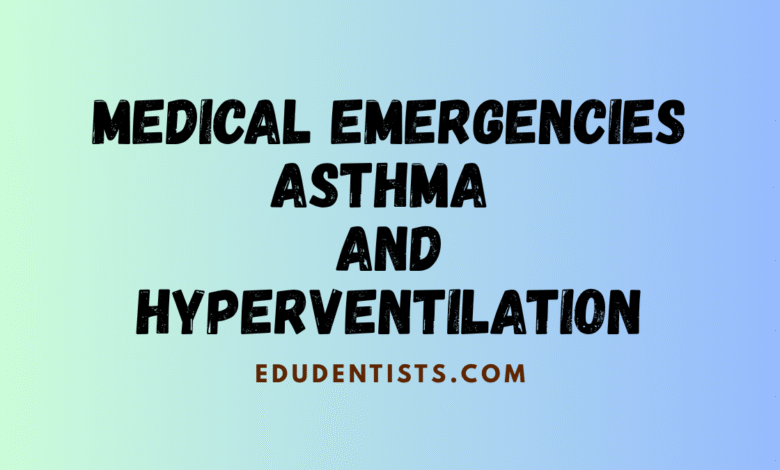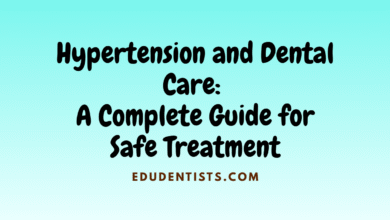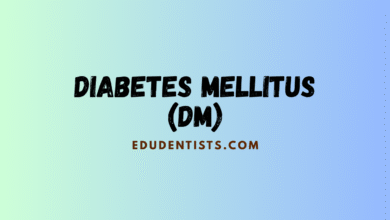Medical Emergencies in Dentistry: Asthma and Hyperventilation
Medical Emergencies in Dentistry: Asthma and Hyperventilation

Medical Emergencies in Dentistry: Asthma and Hyperventilation
Medical Emergencies in Dentistry: Asthma and Hyperventilation
📌 Introduction
Medical emergencies in dentistry can happen at any time. Two of the most common emergencies are asthma attacks and hyperventilation—especially during stressful dental procedures.
This article explains the causes, symptoms, and emergency management of these conditions to help dental professionals keep patients safe and calm.
😮💨 Asthma in the Dental Office
✅ What is Asthma?
Asthma is a chronic respiratory condition that causes:
- Narrowed airways
- Bronchial inflammation
- Mucus build-up
- Difficulty exhaling
It can be triggered by allergens, infections, cold air, or stress—making it a real concern during dental visits.
🔍 Types of Asthma
- Extrinsic Asthma (Allergic): Triggered by environmental allergens; common in children.
- Intrinsic Asthma (Non-Allergic): Linked to infections or irritants; starts after age 35; tends to be more persistent.
🚨 Asthma Attack Symptoms
- Coughing or wheezing
- Shortness of breath
- Chest tightness
- Fast heartbeat
- Anxiety or panic
- Blue lips or fingertips (cyanosis in severe cases)
🦷 Oral Health Risks from Asthma
- Dry mouth (from inhalers)
- Oral candidiasis (fungal infection)
- Higher risk of dental caries
Tip: Remind patients to rinse their mouth after inhaler use.
🆘 Asthma Emergency Management (Step-by-Step)
- Stop all dental work.
- Remove materials from the mouth.
- Sit the patient upright.
- Let the patient use their reliever inhaler (e.g., salbutamol).
- Administer oxygen, if needed.
- If symptoms persist:
- Give epinephrine (0.3–0.5 mL IM)
- Call emergency services
- Monitor vital signs and stay with the patient.
🛡️ How to Prevent Asthma Attacks in the Clinic
- Take a complete medical history.
- Avoid aerosol-producing tools when possible.
- Schedule during low-stress times for the patient.
- Always ask the patient to bring their inhaler to the appointment.
😮💨 Hyperventilation in Dental Patients
✅ What is Hyperventilation?
Hyperventilation is fast, deep breathing often caused by dental anxiety. It leads to low carbon dioxide (CO₂) levels in the blood, causing lightheadedness and other symptoms.
🚨 Signs and Symptoms of Hyperventilation
- Rapid breathing
- Chest tightness
- Dizziness or lightheadedness
- Tingling in the fingers or around the mouth
- Panic or fear
- Muscle cramps (in severe cases)
🆘 How to Manage Hyperventilation in the Dental Office
- Stop dental treatment immediately.
- Sit the patient upright.
- Calm the patient: speak clearly and slowly.
- Coach breathing:
“Breathe in slowly… hold… now exhale slowly.”
Repeat until symptoms reduce. - Do NOT give oxygen.
- Avoid paper bags (unless instructed by a physician).
- If the patient doesn’t recover, call EMS and consider mild anti-anxiety medication like Diazepam.
🧰 Be Ready: Emergency Preparedness for Dentists
- Keep an emergency kit ready:
- Oxygen
- Salbutamol inhaler
- Epinephrine injection
- Diazepam (if permitted)
- Train your team in BLS (Basic Life Support)
- Review patient medical history every visit
- Have a clear emergency plan for the whole dental team
📈 Why This Matters
Up to 44% of dental clinics report medical emergencies every year. Being prepared helps prevent life-threatening outcomes and builds patient trust in your care.
✅ Conclusion
Knowing how to handle asthma attacks and hyperventilation in the dental chair is a vital skill. Preparation, recognition, and calm intervention ensure safe, professional care for your patients.



